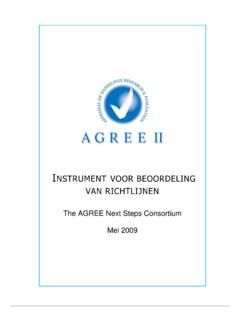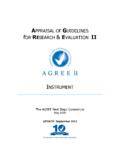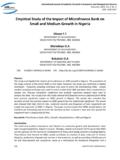Transcription of APPRAISAL OF GUIDELINES FOR RESEARCH ... - …
1 APPRAISAL OF GUIDELINES FOR RESEARCH & evaluation II INSTRUMENT _____ The agree Next Steps Consortium May 2009 UPDATE: December 2017 ii COPYRIGHT AND REPRODUCTION This document is the product of an international collaboration. It may be reproduced and used for educational purposes, quality assurance programmes and critical APPRAISAL of GUIDELINES . It may not be used for commercial purposes or product marketing. Only approved non-English language versions of the agree II Instrument should be used, where available. Offers of assistance in translation into other languages are welcome, provided they conform to the protocol set out by The agree RESEARCH Trust. DISCLAIMER The agree II Instrument is a generic tool designed primarily to help guideline developers and users assess the methodological quality of GUIDELINES . The authors do not take responsibility for the improper use of the agree II Instrument.
2 The agree RESEARCH Trust, May 2009. The agree RESEARCH Trust, September 2013. agree Enterprise December 2017. SUGGESTED CITATION FOR agree II PUBLICATION Brouwers MC, Kho ME, Browman GP, Burgers JS, Cluzeau F, Feder G, Fervers B, Graham ID, Grimshaw J, Hanna SE, Littlejohns P, Makarski J, Zitzelsberger L, for the agree Next Steps Consortium. agree II: Advancing guideline development, reporting and evaluation in healthcare. CMAJ 2010;182:E839-842. SUGGESTED CITATION FOR agree II PDF VERSION agree Next Steps Consortium (2017). The agree II Instrument [Electronic version]. Retrieved <Month, Day, Year>, from FUNDING The development of the agree II Instrument was funded by a grant from the Canadian Institutes of Health RESEARCH (FRN77822) FOR FURTHER INFORMATION ABOUT THE agree II, PLEASE CONTACT agree Project Office, agree Website, iii agree NEXT STEPS CONSORTIUM MEMBERSHIP Dr. Melissa C.
3 Brouwers Principal Investigator, agree Next Steps Consortium McMaster University, Hamilton, Ontario, Canada Consortium Members: Dr. Browman, Victoria, British Columbia, Canada Dr. Burgers, Dutch College of General Practitioners, Utrecht, The Netherlands Dr. F. Cluzeau, Global Health and Development Group, Imperial College London, UK Dr. D. Davis, Association of American Medical Colleges, Washington DC, USA Dr. G. Feder, University of Bristol, UK Dr. B. Fervers, Cancer et Environement, Centre L on B rard, France Dr. I. Graham, Ottawa Hospital RESEARCH Institute, Ottawa, Ontario, Canada Dr. J. Grimshaw, Ottawa Hospital RESEARCH Institute, Ottawa, Ontario, Canada Dr. Hanna, McMaster University, Hamilton, Ontario, Canada Ms. Kho, McMaster University, Hamilton, Ontario Canada Dr. P. Littlejohns, Kings College London, UK Ms. J. Makarski, Hamilton, Ontario, Canada Dr. L. Zitzelsberger, Quebec, Canada agree II VERSIONS & UPDATES agree II Original Public Release and Publication Date: 2009/2010 agree II Update: September 2013 agree II Update: December 2017 What s new in the December 2017 update?
4 The August 2017 update includes revisions to the following sections of the Introduction: agree Website: Resources and References , 10 Years of agree , and Scoring the agree II . Guidance has been added regarding the use of agree II score thresholds to distinguish between higher and lower quality GUIDELINES . In addition, minor editorial changes have been made throughout the Introduction and User s Manual. The content of the agree II Instrument itself has not been modified since 2009 and all versions of the agree II remain valid for use. iv TABLE OF CONTENTS I. INTRODUCTION I. Overview .. 1 II. Applying the agree II .. 3 III. agree Website: Resources and References .. 3 IV. 10 Years of agree .. 4 II. USER S MANUAL: INSTRUCTIONS FOR USING THE agree II.
5 6 I. Preparing to Use the agree II .. 7 II. Structure and Content of the agree II .. 7 III. Rating Scale and User s Manual Sections .. 8 IV. Scoring the agree II .. 9 V. Overall Assessment .. 10 VI. Guidance for Rating Each Item a. Domain 1. Scope and Purpose .. 11 b. Domain 2. Stakeholder Involvement .. 15 c. Domain 3. Rigour of Development .. 19 d. Domain 4. Clarity of Presentation .. 28 e. Domain 5. Applicability .. 32 f. Domain 6. Editorial Independence .. 37 g. Overall Guideline Assessment .. 40 III. agree II INSTRUMENT .. 42 I. Domain 1. Scope and Purpose .. 43 II. Domain 2. Stakeholder Involvement .. 44 III. Domain 3. Rigour of Development .. 45 IV. Domain 4. Clarity of Presentation .. 48 V. Domain 5. Applicability .. 49 VI. Domain 6. Editorial Independence .. 51 VII. Overall Guideline Assessment .. 52 0 I. INTRODUCTION I. OVERVIEW i) Purpose of the agree II Instrument Clinical practice GUIDELINES ( GUIDELINES ) are systematically developed statements to assist practitioner and patient decisions about appropriate health care for specific clinical circumstances (1).
6 In addition, GUIDELINES can play an important role in health policy formation (2,3) and have evolved to cover topics across the health care continuum ( , health promotion, screening, diagnosis). The potential benefits of GUIDELINES are only as good as the quality of the GUIDELINES themselves. Appropriate methodologies and rigorous strategies in the guideline development process are important for the successful implementation of the resulting recommendations (4-6). The quality of GUIDELINES can be extremely variable and some often fall short of basic standards (7-9). The APPRAISAL of GUIDELINES for RESEARCH & evaluation ( agree ) Instrument (10) was developed to address the issue of variability in guideline quality. To that end, the agree instrument is a tool that assesses the methodological rigour and transparency in which a guideline is developed. The original agree instrument was refined, which resulted in the agree II, and a User s Manual was developed (11-13).
7 The purpose of the agree II, is to provide a framework to: 1. Assess the quality of GUIDELINES ; 2. Provide a methodological strategy for the development of GUIDELINES ; and 3. Inform what information and how information ought to be reported in GUIDELINES . The agree II replaces the original instrument as the preferred tool and can be used as part of an overall quality mandate aimed to improve health care. ii) History of the agree Project The original agree Instrument was published in 2003 by a group of international guideline developers and researchers, the agree Collaboration (10). The objective of the Collaboration was to develop a tool to assess the quality of GUIDELINES . The agree Collaboration defined quality of GUIDELINES as the confidence that the potential biases of guideline development have been addressed adequately and that the recommendations are both internally and externally valid, and are feasible for practice (10).
8 The assessment includes judgments about the methods used for developing the GUIDELINES , the components of the final recommendations, and the factors that are linked to their uptake. The result of the Collaboration s effort was the original agree Instrument, a 23-item tool comprising 6 quality domains. The agree Instrument has been translated into many languages, has been cited in over 600 publications, and is endorsed by several health care organizations. More details about the original instrument and related publications are available on the agree Website ( ). As with any new assessment tool, it was recognized that ongoing development was required to strengthen the measurement properties of the instrument and to ensure its usability and feasibility among intended users. This led several members of the original team to form the 1 agree Next Steps Consortium (Consortium).
9 The objectives of the Consortium were to further improve the measurement properties of the instrument, including its reliability and validity; to refine the instrument s items to better meet the needs of the intended users; and to improve the supporting documentation ( , original training manual and user s guide) to facilitate the ability of users to implement the instrument with confidence. The result of these efforts is the agree II, which is comprised of the new User s Manual and 23 item tool organized into the same six domains, described here. The User s Manual is a significant modification of the original training manual and user s guide and provides explicit information for each of the 23 items. Table 1 compares the items of the original agree to the items in the agree II. Table 1. Comparison of the original agree and agree II items. Original agree Item agree II Item Domain 1. Scope and Purpose 1.
10 The overall objective(s) of the guideline is (are) specifically described. No change 2. The clinical question(s) covered by the guideline is (are) specifically described. The health question(s) covered by the guideline is (are) specifically described. 3. The patients to whom the guideline is meant to apply are specifically described. The population (patients, public, etc.) to whom the guideline is meant to apply is specifically described. Domain 2. Stakeholder Involvement 4. The guideline development group includes individuals from all the relevant professional groups. No change 5. The patients views and preferences have been sought. The views and preferences of the target population (patients, public, etc.) have been sought. 6. The target users of the guideline are clearly defined. No change 7. The guideline has been piloted among end users. Delete item. Incorporated into user guide description of item 19. Domain 3. Rigour of Development 8.











